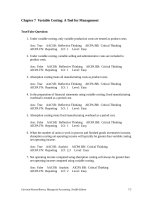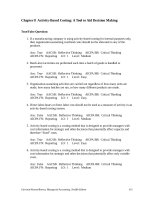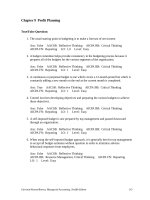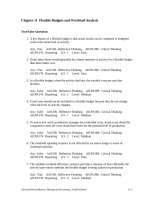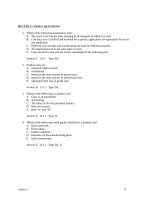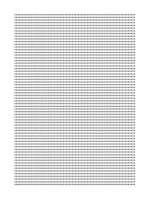Test bank managerial accounting by hilton 9e chapter06
Bạn đang xem bản rút gọn của tài liệu. Xem và tải ngay bản đầy đủ của tài liệu tại đây (554.04 KB, 658 trang )
################################################################################
################################################################################
################################################################################
################################################################################
################################################################################
################################################################################
################################################################################
################################################################################
################################################################################
################################################################################
################################################################################
################################################################################
################################################################################
################################################################################
################################################################################
################################################################################
################################################################################
################################################################################
################################################################################
################################################################################
################################################################################
################################################################################
################################################################################
################################################################################
################################################################################
################################################################################
################################################################################
################################################################################
################################################################################
################################################################################
################################################################################
################################################################################
################################################################################
################################################################################
################################################################################
################################################################################
################################################################################
################################################################################
################################################################################
################################################################################
################################################################################
################################################################################
################################################################################
################################################################################
################################################################################
################################################################################
################################################################################
################################################################################
################################################################################
################################################################################
################################################################################
################################################################################
################################################################################
################################################################################
################################################################################
################################################################################
################################################################################
################################################################################
################################################################################
################################################################################
################################################################################
################################################################################
################################################################################
################################################################################
################################################################################
################################################################################
################################################################################
################################################################################
################################################################################
################################################################################
################################################################################
################################################################################
################################################################################
################################################################################
################################################################################
################################################################################
################################################################################
################################################################################
################################################################################
################################################################################
################################################################################
################################################################################
################################################################################
################################################################################
################################################################################
################################################################################
################################################################################
################################################################################
################################################################################
################################################################################
################################################################################
################################################################################
################################################################################
################################################################################
################################################################################
################################################################################
################################################################################
################################################################################
################################################################################
################################################################################
################################################################################
################################################################################
################################################################################
################################################################################
################################################################################
################################################################################
################################################################################
################################################################################
################################################################################
################################################################################
################################################################################
################################################################################
################################################################################
################################################################################
################################################################################
################################################################################
################################################################################
################################################################################
################################################################################
################################################################################
################################################################################
################################################################################
################################################################################
################################################################################
###############################################################################
################################################################################
################################################################################
################################################################################
################################################################################
################################################################################
################################################################################
################################################################################
################################################################################
################################################################################
################################################################################
################################################################################
################################################################################
################################################################################
################################################################################
################################################################################
################################################################################
################################################################################
################################################################################
################################################################################
################################################################################
################################################################################
################################################################################
################################################################################
################################################################################
################################################################################
################################################################################
################################################################################
################################################################################
################################################################################
################################################################################
##############################################################################ut
.
B.
nothing is manufactured at a work center until a need is signaled
from a subsequent process.
C.
work-in-process inventories are increased
throughout the plant.
D.
production employees never have idle time,
resulting in increased efficiency. E.
defective products are "pulled" off
the line and sent to a special department for rework. Answer: B
LO: 8
Type:
RC
29.
A Kanban:
A.
is used in conjunction with activity-based
costing.
B.
facilitates quick and inexpensive setups of machines.
C.
helps train workers to do a variety of assignments. D.
initiates
production in a particular work center. E.
measures the correlation between
a cost driver and a cost pool. Answer: D
LO: 8
Type: RC
30.
Which of the following is not a key feature of a JIT system?
A.
Purchases of materials in relatively large amounts (i.e., lot sizes). B.
A smooth, uniform production rate. C.
Total quality control. D.
Multiskilled workers and flexible production facilities.
E.
A pull
approach to coordinating steps in the production process. Answer: A
LO: 8
Type: RC
31.
Which of the following statements regarding a JIT system is
(are) true?
Materials are purchased and goods are produced only as
required.Employees are highly skilled at single tasks in an effort to maintain
quality control.A JIT system is characterized by many small purchases of raw
materials.
A.
I only.
B.
I and II.
C.
I and III. D.
II and III.
E.
I, II, and III. Answer: C
LO: 8
Type: RC
32.
Which of the following statements regarding quality is (are) true for a
company that has implemented a JIT system?
JIT requires quality
production facilities, methods, and employees.JIT requires the acquisition of
quality raw materials.JIT requires that long-term contracts be negotiated with
quality suppliers.
A.
II only.
B.
I and II.
C.
I
and III.
D.
II and III.
E.
I, II, and III. Answer: E
LO: 8
Type: RC
33.
A firm that uses a JIT purchasing philosophy probably:
A.
has many suppliers.
B.
has extensive inspection of purchased items
at the receiving point.
C.
has relatively few suppliers.
D.
has
deliveries of purchased items made in small lot sizes immediately before the
goods are needed in production.
E.
has relatively few suppliers and has
deliveries of purchased items made in small lot sizes immediately before the
goods are needed in production. Answer: E
LO: 8
Type: RC
34.
Which of the following statements is (are) true about JIT purchasing
as compared with conventional purchasing systems?
Quality control by
the supplier is more crucial.Adherence to delivery schedules by vendors is more
crucial.Long-term supplier contracts are common.
A.
I only
B.
II only.
C.
III only.
D.
I and II.
E.
I, II, and III.
Answer: E
LO: 8
Type: N
35.
Which of the following statements
about a just-in-time (JIT) purchasing system is false?
A.
Since there is
minimal backup, companies must acquire quality raw materials.
B.
Raw
materials are stockpiled to avoid production disruptions. C.
In comparison
with experiences under traditional systems, manufacturers normally deal with a
reduced number of suppliers. D.
Supplier reliability tends to be more
important under a JIT system than under a traditional purchasing system.
E.
The average purchase size is smaller with a JIT system than under a
traditional purchasing system. Answer: B
LO: 8
Type: RC
36.
Hudson,
Inc., is considering a change from a traditional purchasing system to a just-intime purchasing system. What has probably happened to Hudson's cost per
purchase order and inventory unit storage cost to prompt the company to consider
such a change?
A.
Purchase-order cost is increasing and unit storage cost
is increasing.
B.
Purchase-order cost is increasing and unit storage cost
is decreasing.
C.
Purchase-order cost is decreasing and unit storage cost
is increasing.
D.
Purchase-order cost is decreasing and unit storage cost
is decreasing.
E.
Both of these costs are relatively stable in amount.
Answer: C
LO: 8
Type: N
37.
When a company adopts a just-in-time
inventory system, it would expect: A.
higher inventories and less frequent
purchases. B.
higher inventories and more frequent purchases.
C.
lower inventories and less frequent purchases. D.
lower inventories and
more frequent purchases.
E.
lower inventories and more units purchased
on a given order. Answer: D
LO: 8
Type: N
38.
When a company adopts a just-in-time inventory system, it would
expect:
A.
higher inventories and fewer units purchased on a given order.
B.
higher inventories and more units purchased on a given order.
C.
lower inventories and fewer units purchased on a given order.
D.
lower inventories and more units purchased on a given order.
E.
lower inventories and less frequent purchases. Answer: C
LO: 8
Type:
RC
39.
Roger Corporation recently abandoned its traditional production and
inventory system in favor of a just-in-time system. The company typically dealt
with 50 suppliers and placed 450 orders throughout the year. All other things
being equal, which of the following choices denotes a likely scenario under the
just-in-time system?#Numberof Suppliers#Number of
Orders##A.#35#200##B.#35#750##C.#50#450##D.#60#200##E.#60#750##Answer: B
LO: 8
Type: N
40.
Harold Corporation recently abandoned its traditional
production and inventory system in favor of a just-in-time system. The company
typically ordered 700 units of raw material at a time and purchased units that
scored a 7 on a 10-point quality scale, with 10 being very close to perfection.
All other things being equal, which of the following choices denotes a likely
scenario under the just-in-time system?#Order Size#Quality
Purchased##A.#300#7##B.#300#9##C.#700#9##D.#950#7##E.#950#9##Answer: B
LO: 8
Type: N
41.
When a company switches from a traditional system to a justin-time production and inventory system, what often happens to the quality of
raw material purchased and the number of vendors that supply the firm?#Quality
of Purchases##Number of
Suppliers##A.#Increase##Increase##B.#Increase##Decrease##C.#Decrease##Increase##
D.#Decrease##Decrease##E.#Increase##Remain the same##Answer: B
LO: 8
Type:
RC
Which of the following would not typically be used or encountered by a firm that
is in the service industry?Customer profitability analysis.Activity-based
management.Non-value-added activities.Value-added activities.None of the above,
as all would typically be used or encountered by a service provider.
Answer: E
LO: 9
Type: RCEXERCISESValue-Added and Non-Value-Added ActivitiesConsider the
nine activities that follow.1.
Microsoft: Developing computer coding for a
new spreadsheet package2.
General Mills: Painting the office of a
maintenance supervisor at a plant that produces cereal3.
Mayo Clinic:
Examining a new patient4.
American Airlines: The 90 minutes that a Boeing
757 sits idle on the ground between flights5. Office Depot: Moving cases of
paper from one location to another in the same warehouse 6.Rolex: Attaching a
watch band to the watch�s face7.
United States Postal Service: Reprocessing
mail that had been sorted incorrectly on a malfunctioning sorting machine. 8.
Fidelity Investments: Correcting errors made by company personnel in
customer accounts9.
Marriott: Upgrading the quality of bedding used at
hotels in very competitive marketplacesRequired:Categorize each of the
activities as either value-added or non-value-added for the companies noted. LO:
3
Type: N Answer:1.#Value-added#6.#Value-added##2.#Non-value added#7.#Nonvalue-added##3.#Value-added#8.#Non-value-added##4.#Non-value-added#9.#Valueadded##5.#Non-value-added####
Non-Value-Added Activities; Customer Profitability
44.
Switzer, Inc., which
sells books to college bookstores and individuals, uses activity-based costing
and activity-based management.
The following information is available for the
company's three cost pools:
Activity#Cost Driver#Cost-Driver Quantity#Percent of Cost- Driver Activity for
Bookstore Transactions #Percent of Cost- Driver Activity for Transactions to
Individuals ##Incoming receipts#Number ofpurchase orders# 3,000#20%#
80%########Warehousing#Number of inventory moves#
8,000#60#40########Outgoing
shipments#Number of shipments#18,000#30#70##
Bookstore sales
totaled $8,400,000, and sales to individuals amounted to $2,400,000. Costs for
the three activities were: Incoming receipts, $450,000; warehousing, $520,000;
and outgoing shipments, $630,000. A review of the company's activities found
various inefficiencies with respect to the warehousing of textbooks (acquired
for eventual sale to bookstores) and outgoing shipments to individuals. These
inefficiencies resulted in an extra 500 moves and 400 shipments, respectively.
Required:What is a non-value-added activity? How much did nonvalue-added activities cost Switzer this past year?Which of the two
markets�sales to bookstores or sales to individuals�resulted in lower overall
costs for incoming receipts, warehousing, and outgoing shipments?
Evaluate
these costs in both absolute dollars and as a percentage of sales. In addition,
present a possible explanation for your results. Note: Exclude costs that arose
from inefficient operations. LO: 3, 4
Type: A, N
Answer: A.#Non-value-added activities can be defined as activities that are
either (1) unnecessary and dispensable or (2) necessary but inefficient and
improvable. Put simply, such activities can be eliminated without harming
overall quality, performance, or perceived value. ##B.#Cost of non-value-added
activities:Incoming receipts: $450,000
################################################################################
################################################################################
###########�� #3#,#0#0#0# #p#u#r#c#h#a#s#e# #o#r#d#e#r#s# #=# #$#1#5#0# #p#e#r#
#p#u#r#c#h#a#s#e# #o#r#d#e#r# ##W#a#r#e#h#o#u#s#i#n#g#:# #$#5#2#0#,#0#0#0# #��
#8#,#0#0#0# #i#n#v#e#n#t#o#r#y# #m#o#v#e#s# #=# #$#6#5# #p#e#r# #m#o#v#e#
#O#u#t#g#o#i#n#g# #s#h#i#p#m#e#n#t#s#:# #$#6#3#0#,#0#0#0# #�� #1#8#,#0#0#0#
#s#h#i#p#m#e#n#t#s# #=# #$#3#5# #p#e#r# #s#h#i#p#m#e#n#t# #
#######W#a#r#e#h#o#u#s#i#n#g#:# #5#0#0# #m#o#v#e#s# #x#
#$#6#5###$#3#2#,#5#0#0#######O#u#t#g#o#i#n#g# #s#h#i#p#m#e#n#t#s#:# #4#0#0#
#s#h#i#p#m#e#n#t#s# #x $35# 14,000 ###Total#$46,500##C.#Sales to bookstores
produced lower overall costs in both absolute dollars and as a percentage of
sales. A possible explanation lies in the fact that sales to individuals
resulted in the sale of one or two copies per shipment and order. In contrast,
bookstore sales likely produced greater revenues and efficiencies because of the
large number of texts sold per transaction. ##Activity#Cost-DriverQuantity#%
Bookstores#% Individuals#Driver-Quantity: Bookstores#Driver-Quantity:
Individuals##Incoming receipts#3,000#20%#80%# 600#2,400##Warehousing#
8,000#60%#40%#
4,300*#3,200##Outgoing
shipments#18,000#30%#70%#5,400#12,200**#########* (8,000 moves x 60%) 500##**(18,000 shipments x 70%) - 400##
#Bookstores#Individuals##Incoming receipts:####600 purchase orders x $150#$
90,000###2,400 purchase orders x $150##$360,000##Warehousing:####4,300 moves x
$65# 279,500###3,200 moves x $65## 208,000##Outgoing shipments:####5,400
shipments x $35# 189,000###12,200 shipments x $35## 427,000##Total
cost#$558,500#$995,000##Cost as a percentage of sales:####$558,500
( $8,400,000#6.65%###$995,000 ( $2,400,000##41.46%##
Customer Profitability Analysis
45.
Clark Corporation manufactures cooling
system components. The company has gathered the following information about two
of its customers: Engle Equipment and Midwest Refrigeration.
#Engle
Equipment#Midwest Refrigeration##Sales revenue#$215,000#$154,000##Cost of goods
sold#
95,000#
68,000##General selling costs#
30,000#
21,500##General
administrative costs#
21,000#
15,050##Cost-driver data used by the firm
and traceable to Engle and Midwest are:##Customer Activity#Cost Driver#Rate per
Unitof Cost Driver##Sales activity##Sales visits#$900##Order taking##Sales
orders# 250##Special handling##Units handled#
30##Special
shipping##Shipments# 600##Customer Activity##EngleEquipment##Midwest
Refrigeration##Sales activity##
8 visits##
5 visits##Order taking##
17 orders##
22 orders##Special handling## 600 units## 550 units##Special
shipping##
19 shipments##
30 shipments##
Required:
Perform a customer profitability analysis for Clark. Compute the gross margin
and operating income on transactions related to Engle Equipment and Midwest
Refrigeration.Compute gross margin as a percentage of sales revenue. Then
compute (1) general selling and administrative costs as a percentage of gross
margin and (2) total customer-related costs (i.e., costs that arise from sales
visits, order taking, and special handling and shipping) as a percentage of
gross margin. On the basis of your calculations, which of the two customers is
"more costly" to deal with? Briefly explain. LO: 4
Type: A, N
Answer: A.#In dollar terms, Engle's gross margin and operating income are
greater than those of Midwest Refrigeration.####EngleEquipment#Midwest
Refrigeration###Sales revenue#$215,000##$154,000###Cost of goods sold#
95,000##
68,000###Gross margin#$120,000##$ 86,000###Selling and
administrative costs:######General selling costs#$ 30,000##$ 21,500###General
administrative costs#21,000## 15,050###Customer-related costs:######Sales
visits (8, 5 x $900)#
7,200## 4,500###Order taking (17, 22 x $250)#4,250##
5,500###Special handling (600, 550 x $30)#18,000##
16,500###Special shipping
(19, 30 x $600)#
11,400##
18,000###Total#$
91,850##$
81,050###Operating income#$
28,150##$
4,950##B.#Gross margin as a % of
sales revenue:
Engle: $120,000 � $215,000 = 55.81%
Midwest:
$86,000 � $154,000 = 55.84%
General selling and administrative costs as a % of
gross margin:
Engle: ($30,000 + $21,000) � $120,000 = 42.5% Midwest:
($21,500 + $15,050) � $86,000 = 42.5%Customer-related costs as a % of gross
margin:
Engle: ($7,200 + $4,250 + $18,000 + $11,400) � $120,000 = 34.0%
Midwest: ($4,500 + $5,500 + $16,500 + $18,000) � $86,000 = 51.7%##C.#Both
customers produce approximately the same rate of gross margin on sales and are
charged with the same percentage of general selling and administrative costs.
The difference lies in the area of customer-related costs. Midwest's costs make
the firm a more expensive client to deal with than Engle. Given the dollar
volume of sales revenue that is generated, Midwest's special handling and
shipping needs (especially the latter) are an expensive proposition for Clark
Corporation.##
Customer Profitability Data: Computation and Analysis 46.
Homestead Corporation
sells a line of power tools to home improvement chains, generating a cost of
goods sold equal to 70% of net sales. The selected data that follow relate to
the period just ended for the company's three largest customers: Weekend
Project, Tool Mart, and Fix-It City.
#Weekend Project# Tool Mart#
Fix-It City##Gross sales volume:######Dollars# $2,000,000##$4,900,000#
$4,600,000##Number of orders# 50##
175#125##Type of
order:######Regular# 40##
135# 110##Rush#
10##
40#
15##Sales returns:######Dollars#
$100,000##
$400,000#
$240,000##Number
of returns#
3## 20#
8##Total customer-related costs#
$245,100##
$918,000#
$457,800##
Homestead's management recently
attended a seminar and learned that customers with excessive requests and
demands can have a significant, negative impact on corporate profitability.
Required:For each of the three chains, compute:Total customerrelated costs as a percentage of gross margin.The average order size (ignoring
sales returns).The ratio of regular orders to rush orders.The number of sales
returns as a percentage of the number of total orders.Prepare a brief summary of
your findings. Should Homestead work with any of the chains in an effort to
improve results? Explain. LO: 4
Type: A, N
Answer: A.#1.#Customer-related costs as a percentage of gross margin:####Weekend
Project: $245,100 � [($2,000,000 - $100,000) x 30%] = 43%####Tool Mart: $918,000
� [($4,900,000 - $400,000) x 30%] = 68%####Fix-It City: $457,800 � [$4,600,000 $240,000) x 30%] = 35%###2.#Average order size:####Weekend Project: $2,000,000 �
50 orders = $40,000####Tool Mart: $4,900,000 � 175 orders = $28,000####Fix-It
City: $4,600,000 � 125 orders = $36,800###3.#Ratio of regular orders to rush
orders:####Weekend Project: 40:10 = 4:1####Tool Mart: 135:40 = 3.375:1####Fix-It
City: 110:15 = 7.33:1###4.#Number of sales returns as a percentage of total
orders:####Weekend Project: 3 � 50 = 6%####Tool Mart: 20 � 175 = 11.4%####Fix-It
City: 8 � 125 = 6.4%##B.#Customer-related costs are driven by events (and costs)
directly traceable to clients. In this case, Tool Mart's costs as a percentage
of gross margin are much higher (68%) than those of Weekend Project and Fix-It
City. This result is not surprising given that the firm creates a large number
of small orders ($28,000 vs. $36,800 and $40,000) for Homestead to process. In
addition, relative to the other two firms, Tool Mart relies more heavily on rush
orders, which likely creates additional cost. Finally, a number of Tool Mart's
orders (11.4%) eventually result in sales returns, again creating additional
processing expense for Homestead. In summary, Tool Mart seems to be an outlier
in relation to Weekend Project and Fix-It City, and management should approach
Tool Mart to see if the firm can change its ways of doing business.##
Customer Analysis
47.
Beaverton Manufacturing is a relatively new
customer of Haxton Enterprises. In the short period that the two companies have
done business with each other, Haxton has found Beaverton to be, in management's
words, "an expensive proposition." Numerous sales visits are typically required
to "close a deal," with selling prices and discounts offered being among the
most attractive in the industry. Complicating matters, Beaverton is slow to
settle its account, orders in small quantities, and often has numerous
specialized shipping and handling needs.
A recent customer
profitability analysis has painted a very negative picture of Beaverton
Manufacturing, and Haxton's managers are questioning whether an on-going
relationship with the firm is warranted.
Required:
Briefly explain why the customer profitability analysis painted a negative
picture of Beaverton Manufacturing.What actions are available to Haxton
Enterprises to improve Beaverton profitability?LO: 4
Type: N
Answer: Profit
is a function of two basic factors�revenues and expenses�and Haxton is being
squeezed on both elements. Prices are low, discounts are high, and order sizes
are small. Furthermore, the costs of working with Beaverton are high, courtesy
of numerous sales calls being required to produce a sale, a slow-paying
customer, and specialized handling and shipping needs.Haxton should attempt to
work with Beaverton in a cost-cutting drive, explaining that favorable terms can
only be extended for a short period of time. Acceleration of amounts due,
increases in order size, and reductions in sales visits and specialized handling
and shipping needs are possible topics for discussion/improvement. If Haxton is
unsuccessful in its efforts, price hikes and/or elimination of discounts may be
in order.
Target Costing
48.
In the not-too-distant future, Victor
Enterprises will introduce a new printer for desktop computers. This printer is
expected to compete successfully with other models that are anticipated to sell
for $250. Victor's printer has several unique features, and management believes
that a slightly higher selling price (10%) is justified. The company's normal
profit margin is 30% of selling price.
Required:What is the
printer's target price, target profit, and target cost?Suppose that Victor's
engineers and cost accountants conclude that the present design of the printer
will result in a unit cost of $210. Explain the concept of "value engineering"
and be sure to note how it can assist Victor Enterprises in achieving its goals.
LO: 5
Type: A, N
Answer: Target price: $250 + ($250 x 10%) = $275Target profit: $275 x 30% =
$82.50Target cost: $275 - $82.50 = $192.50Victor's present cost is too high to
achieve the desired profit margin, meaning that some form of cost reduction is
needed. Value engineering is a cost-reduction and process-improvement technique
that may allow the company to produce the printer at its targeted cost of
$192.50. Engineers will examine the unit in terms of parts and process
complexity, putting forth recommendations of where changes can be made. Target
CostingHudson Valley sells barbeque grills in an increasingly competitive
environment. For a number of years, management has followed a successful policy
of marking up goods by 20% of cost, the company�s desired gross margin.One of
the firm�s products, grill no. 56, has direct-material charges of $80, directlabor cost of $50, and manufacturing overhead of $70. This grill is designed to
compete against others in the marketplace that wholesale for an average of $220.
In the last year or so, management has observed a decline in unit sales volume
despite a very favorable write-up in both Grillmaster magazine and Consumer
Watchdog.
Required:Explain a probable cause of the decline in unit sales
volume.What would be the likely selling price if the firm uses target costing?
What must happen to the current manufacturing cost if Hudson Valley were to
achieve its 20% gross margin, now computed on the basis of sales? By how much?
LO: 5
Type: A, NAnswer:The problem does not seem to be qualityrelated because of the grill�s favorable reviews. Rather, Hudson Valley is in a
very competitive marketplace and appears to be over-pricing the grill somewhat
for the intended market segment. That is, the costs of grill no. 56 total $200
($80 + $50 + $70). With a 20% markup added, the selling price becomes $240
[$200 + ($200 x 20%)] when the average selling price is $220.$220If the selling
price is $220 and the company has a 20% gross margin on sales of $44 ($220 x
20%), the grill�s costs must total $176 ($220 - $44). Thus, current costs must
drop by $24 ($200 - $176).
Just-in-Time Purchasing System
50.
The wholesale division of Navigator
Enterprises is considering the installation of a just-in-time purchasing system.
The company's accountant has provided the following figures if the system is
adopted:Sales lost because of out-of-stock situations will total 5,500 units,
with each unit producing an average profit for the firm of $23.The overall
inventory will drop by $700,000. Navigator can invest these funds elsewhere and
produce a return of 13%.A leased warehouse (monthly rent of $3,000) will no
longer be needed. Two warehouse employees (total annual salary cost of $43,000)
will be transferred elsewhere in the firm.Annual property taxes and insurance
are expected to fall by $18,900.In order to keep valued customers, Navigator
will occasionally have to use air freight when an out-of-stock situation arises,
resulting in added cost for the company of $2,300.
Required:
Determine whether it is financially advantageous over a 12-month period for
Navigator to adopt the just-in-time system.How would Navigator describe the
"ideal supplier" if the company adopts the just-in-time system. LO: 8
Type: A,
N
Answer: A.#Lost profits (5,500 units x $23)#$(126,500)###Return on funds
($700,000 x 13%)#
91,000###Lease savings ($3,000 x 12)#
36,000###Savings
in taxes and insurance#
18,900###Air freight costs#
(2,300)###Total#$
17,100###The just-in-time system is financially advantageous to the firm, saving
$17,100. Note: The cost of the warehouse employees is ignored because
regardless of whether the system is adopted, Navigator will incur the cost.
##B.#The "ideal supplier" is one that delivers top quality goods precisely when
needed. Thus, reliability is a key with respect to quality and delivery, as is
close proximity to the wholesale division. Most JIT suppliers are willing to
sign long-term contracts and accept "batched" payments for deliveries.##
Just-in-Time Purchasing System
51.
Management of Laredo Enterprises
recently decided to adopt a just-in-time inventory policy to curb steadily
rising costs and free-up cash for purposes of investment. The company
anticipates that inventory will decrease by $4,450,000, with the released funds
to be invested at a 10% return for the firm. Additional data follow.Reduced
inventories should produce savings in insurance and property taxes of $46,000.
Reduced raw-material inventory levels and accompanying stockouts will cost
Laredo $85,000. Laredo will lease 80% of an existing warehouse to another firm
for $2.50 per square foot. The warehouse has 40,000 square feet.Four employees
who currently earn $35,000 each will be directly affected by the just-in-time
adoption decision. Three employees will be transferred to other positions with
Laredo; one will be terminated.A shift in suppliers is expected to result in the
purchase and use of more expensive raw materials. However, these materials
should give rise to fewer warranty and repair problems after Laredo's finished
product is sold, resulting in a net savings for the firm of $38,000. Because of
the need to handle an increased number of small shipments from suppliers, Laredo
will remodel production and receiving-dock facilities at a cost of $750,000.
The construction costs will be depreciated over a 10-year life.
Required:Compute the annual financial impact of Laredo's decision to adopt
a just-in-time inventory system.In comparison with those of a traditional
purchasing system, why would the number and size of incoming supplier shipments
change under a just-in-time system? LO: 8
Type: A, N
Answer: A.#Return on
released funds ($4,450,000 x 10%)#$445,000###Savings in insurance and property
taxes#
46,000###Added stockout costs#
(85,000)###Lease revenue (40,000
square feet x 80% x $2.50)#
80,000###Salary savings*#
35,000###Net savings
in materials, warranty, and repair costs#
38,000###Depreciation on remodeled
facilities####($750,000 � 10 years)#
(75,000)###Savings from JIT
system#$484,000######*Note: The cost of the three transferred employees is
excluded because Laredo will continue to have these individuals on the
payroll.##
B.#Under a traditional purchasing system, goods are purchased (frequently in
large lots) and then placed in inventory until used. In contrast, with JIT,
costly inventories are avoided by having the materials arrive "just in time" to
be issued to production. Materials are therefore purchased only when needed,
which often translates into numerous small acquisitions throughout the period.##
Analysis of Just-in-Time Purchasing System
52.
Putnam Enterprises
currently purchases a total of 50,000 sensors annually from Utah Electronics at
$80 per unit. The firm places 25 purchase orders during the year at an average
cost of $10 per order. Putnam's management is contemplating a switch to a justin-time purchasing system that would require an increase in orders to 200.
Required:Compute the average order size under both the current
system and the proposed just-in-time system. Also, calculate the change in
annual purchase-order processing cost.Explain why the number of orders will
increase under a just-in-time system.What benefits might Putnam experience to
help offset the increase in purchase-order processing cost? What might Utah do
to the $80 price, given the company's need to process an additional 175 orders?
LO: 8
Type: A, N
Answer: A.#Current system: 50,000 sensors � 25 orders =
2,000 unitsJust-in-time system: 50,000 sensors � 200 orders = 250 units###Justin-time system: 200 orders x $10 #$2,000###Current system: 25 orders x $10#
250###Increase in purchase-order processing cost#$1,750##B.#Under a traditional
system, orders are large so that adequate inventories can be maintained. By
increasing the number of orders, companies anticipate that units will arrive on
an as-needed basis, thus reducing the need to carry sizable on-hand stocks.
##C.#A reduction in inventories will typically decrease associated costs such as
warehousing, insurance, obsolescence, and property taxes. In addition, monies
currently invested in inventories will be released for other profitable uses by
management. Putnam may also negotiate that a higher quality sensor be acquired,
which would both reduce the need for inspections and increase the overall
quality of the firm's finished product.##D.#Utah's cost will likely increase,
given that overall volume is constant at 50,000 sensors. As a result, the firm
might be forced to raise the sensor's selling price.##
Just-in-Time Purchasing, Non-Value-Added Activities 53.
Fargo Enterprises,
which manufactures lawn mowers, recently installed a just-in-time purchasing
system and an activity-based management program.
Required:
Determine whether the following items would be apt to increase or decrease as a
result of the just-in-time system:Inventory storage costs.Number of suppliers
used.Number of raw material shipments handled.Dollars available for alternative
investment opportunities.Quality of raw materials purchased.
Identify
the following items as value-added activities, non-value-added activities, or
both.Attaching the engine to the mower's body.Installing a new air-conditioning
system in the executive offices.Replacing a defective wheel with a new wheel.
Designing and printing an owner's instruction manual for a new model.Moving
completed mowers to the finished-goods warehouse.Attaching the handle to the
mower's body. The process took longer than normal because of a worker slowdown
caused by disgruntled employees. LO: 3, 8
Type: N Answer:
A.#1.#Decrease#B.#1.#Value-added###2.#Decrease##2.#Non-valueadded###3.#Increase##3.#Non-value-added###4.#Increase##4.#Valueadded###5.#Increase##5.#Non-value-added######6.#Both##DISCUSSION QUESTIONSNonValue-Added Costs
54.
Non-value-added costs occur in nonmanufacturing
organizations as well as in manufacturing firms.
Required:
Explain what is meant by a non-value-added cost.Identify two potential nonvalue-added costs for each of the following service providers: airlines, banks,
and hotels. LO: 3, 9
Type: RC, N
Answer: Non-value-added costs are the costs of activities that can be eliminated
with no deterioration of product quality, performance, or perceived value.
These activities should be eliminated to save time and money. General examples
include the costs of inspection, moving, waiting, and storing.B. Airlines:
The cost of preparing excess food because of forecasting errors in passenger
loads.The cost of tracing, returning, repairing, or replacing lost or mishandled
luggage.Additional compensation paid to flight crews attributable to
cancellations or delays from problems that should have been prevented by routine
maintenance.
Banks:The cost of correcting bank errors in customer
accounts.The cost of performing manual banking procedures necessitated by
computer system downtime.Losses caused by employee embezzlement and petty
thefts.Defaulted loans made to borrowers who should have been classified as poor
risks by existing credit-granting procedures.
Hotels:Broken dishes and
glassware, loss of or damage to linens and towels.The cost of replacing lost
room keys.The cost of overstaffing the front desk during nonpeak hours.Excess
food costs, including preparation. Non-Value-Added Activities
55.
What are
non-value-added activities? What should companies do with these activities and,
in general terms, how should this be done? LO: 3
Type: RC
Answer: Non-valueadded activities are operations that are either (1) unnecessary and dispensable
or (2) necessary, but inefficient and improvable. These activities give rise to
non-value-added costs, which cut into company profitability. Non-value-added
activities should be reduced and/or eliminated through various process
improvement techniques. Activities may also be shared in some cases, with
selected functions being combined and performed in a more efficient manner.
Kaizen Versus Re-engineering
56.
Briefly distinguish between kaizen and
re-engineering. LO: 6, 7
Type: RC
Answer: Kaizen refers to the process of
cost reduction during the manufacturing phase of an existing product. This
process takes place gradually, or through small continual improvements rather
than through radical change. Re-engineering, on the other hand, is a bit more
drastic, often involving the complete redesign of a process in hopes of finding
a creative new way to accomplish an objective. Generally speaking, reengineering often prescribes radical, quick, and significant change. Just-inTime Production
57.
A just-in-time production system uses a "pull
method" to coordinate steps in the manufacturing process. Explain what is meant
by the term "pull method." LO: 8
Type: RC
Answer: Under the pull method,
goods are produced in each manufacturing stage only as they are needed at the
next stage. When materials and parts are required for final assembly, for
example, a message is sent to the preceding work
c###############################################################################
################################################################################
###########################q###r###t###u###�###�#### ##$
##�
##�
##�
##�
##�
##�
##�
##�
##�
##�
##�
##�
##�
##�
##�
##�
##
###
##6
##=
##]
##^
##�
##�
##�
##�
##########S###T###\###]###b###d###f###g###l###o###q###r###y###|
###~###�
�
###�###�###�###�###�###���
� �
�������������������������������������������������������##
#hGDl##hGDl#CJ##OJ##QJ##^J##aJ#####hGDl##hGDl#B*#CJ##aJ##ph######hGDl#B*#CJ##aJ#
#ph######hGDl##h�Oa#;#�CJ##OJ##QJ##^J##aJ##&#hGDl##h�Oa#5#�;#�B*#CJ##\#�aJ##ph##
#####hGDl##h�Oa#B*#CJ##aJ##ph#####>################r###u###�###$ ##�
##�
##�
##�
##�
##�
##�
##�
##�############�############�############�############�############�############
�############�############�############�############�############�############�#
###########�############�#######################################################
�###�###�T##���1$#7$#8$#H$#^�T#`���gdGDl#####
&##F##�
#�####�####��##���1$#7$#8$#H$#^��#`���gdz#�#####
�#######��##�0�1$#7$#8$#H$#^��#`�0�gdGDl#####
�#######��##���1$#7$#8$#H$#^��#`���gdGDl#####1$#7$#8$#H$#######0a##�a##��#######
################################################################################
################################################################################
################################################################################
################################################################################
################################################################################
################################################################################
###########�
###
###
##T###]###g###r###�###�###�###�###�###�
##�



